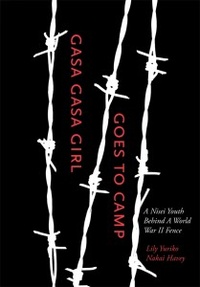Through a sophisticated blend of artwork, prose, and photographic images, plus an assortment of other useful illustrative materials, Lily Yuriko Nakai Havey has crafted in Gasa Gasa Girl Goes to Camp what is assuredly among the very most exquisite, insightful, and candid memoirs of the World War II Japanese American experience.
I vigorously applaud the University of Utah Press’ marketing of this volume—which hinges on Havey’s pre- and early-adolescence incarceration at the Santa Anita Assembly Center in Southern California and the Granada (Amache) Relocation Center in southeastern Colorado—as a “creative memoir.” While all memoirs (a literary genre that in recent years has mushroomed in popularity) embody creativity, the one under review here does so primarily (though certainly not exclusively) through the prism of its exceedingly talented Nisei artist-author’s retrospectively rendered watercolor representations of her wartime past in America’s concentration camps.
In reading Gasa Gasa Girl Goes to Camp, I was reminded of the fictional and non-fictional memoirs penned by a celebrated generational contemporary of Havey’s, the British author Penelope Lively. As in the case of Lively, who writes for both adults and children, Havey (whose accessible and engaging memoir will predictably captivate children and adult readers) likewise stresses the supple power of memory and points up the acute and pervasive tensions between “official” history and personal history.
On the other hand, whereas Penelope Lively’s trademark as a memoirist is her championing of the impact of the past on the present, in her memoir Havey not only promotes this proposition throughout her narrative in historical reflections pertaining to her background and that of her extended family members in the U.S. and Japan, but also dramatizes how the dynamic present shapes our interest in and interpretation of the mutable past. “In the 1980s,” she explains in her preface, “I learned about armed-service personnel suffering from post-traumatic stress disorder (PTSD) and wondered whether some of my unease with confined spaces…bright lights, and loud noises might be symptoms of the same syndrome. (So to find out) I painted a series of watercolors about my (wartime) experiences…”
Thanks to a remarkably perceptive foreword contributed by Cherstin Lyon, a rising star in Japanese American studies and public and oral history, readers of Gasa Gasa Girl Goes to Camp will be better able to ascertain what this book is (“an artistically written record of one woman’s journey into her past”), what it is not (“a factual record of everything that marked the wartime experiences of 120,000 individuals who were caught in a tragic display of intolerance and racial prejudice”), and what, at bottom, is its abiding value (“it intimately shares one woman’s memories of the past and, at the same time…explore(s) issues rarely discussed in any historical or narrative literature about the camp experience, particularly for women”).
This is a book that must be read, shared, discussed, taught—and savored!
GASA GASA GIRL GOES TO CAMP: A Nisei Youth behind a World War II Fence
By Lily Yuriko Nakai Havey
(Salt Lake City: University of Utah Press, 2014, 224 pp., $29.95, cloth, $24, eBook)
*This article was originally published in the Nichi Bei Weekly, on July 24, 2014.
© 2014 Arthur A. Hansen / Nichi Bei Weekly








